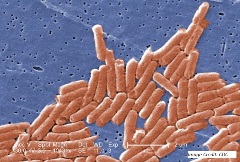From the Centers for Disease Control and Prevention (CDC)
What is Salmonellosis?

Salmonella is a bacteria that makes people sick. Most people infected with Salmonella develop diarrhea, fever, and abdominal cramps between 12 and 72 hours after infection. The illness usually lasts 4 to 7 days, and most individuals recover without treatment. In some cases, diarrhea may be so severe that the patient needs to be hospitalized. In these patients, the Salmonella infection may spread from the intestines to the blood stream, and then to other body sites. In these cases, Salmonella can cause death unless the person is treated promptly with antibiotics. The elderly, infants, and those with impaired immune systems are more likely to have a severe illness
How Common is Salmonella Infection?
CDC estimates that approximately 1.2 million illnesses and approximately 450 deaths occur due to non-typhoidal Salmonella annually in the United States. There are many different kinds of Salmonella bacteria. Salmonella serotype Typhimurium and Salmonella serotype Enteritidis are the most common in the United States. Salmonella infections are more common in the summer than winter. Read more key Salmonella statistics.
Resources for Food Retailers
Centers for Disease Control Salmonella Information
Prevention Tips from CDC
FSIS Salmonella Action Plan: FSIS's strategy to best address the threat of Salmonella in meat and poultry products.
FSIS Proposed Salmonella Performance Standards
FSIS Current Salmonella Performance Standards
Partnership for Food Safety Education (PFSE) Summer without Salmonella
- Food Safety & Security
 Industry Topics address your specific area of expertise with resources, reports, events and more.
Industry Topics address your specific area of expertise with resources, reports, events and more.
 Our Research covers consumer behavior and retail operation benchmarks so you can make informed business decisions.
Our Research covers consumer behavior and retail operation benchmarks so you can make informed business decisions.
 Events and Education including online and in-person help you advance your food retail career.
Events and Education including online and in-person help you advance your food retail career.
 Food Safety training, resources and guidance that help you create a company food safety culture.
Food Safety training, resources and guidance that help you create a company food safety culture.
 Government Affairs work — federal and state — on the latest food industry policy, regulatory and legislative issues.
Government Affairs work — federal and state — on the latest food industry policy, regulatory and legislative issues.
 Get Involved. From industry awards to newsletters and committees, these resources help you take advantage of your membership.
Get Involved. From industry awards to newsletters and committees, these resources help you take advantage of your membership.
 Best practices, guidance documents, infographics, signage and more for the food industry on the COVID-19 pandemic.
Best practices, guidance documents, infographics, signage and more for the food industry on the COVID-19 pandemic.
